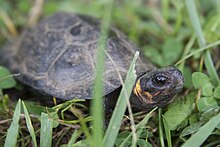
Back لجأة المستنقعات Arabic لجاة المستنقعات ARZ Тресавищна блатна костенурка Bulgarian Baot Muhlenberg Breton Glyptemys muhlenbergii Catalan Glyptemys muhlenbergii CEB Želva Muhlenbergova Czech Moorschildkröte German Glyptemys muhlenbergii Spanish Glyptemys muhlenbergii Basque
| Bog turtle Temporal range: Middle Pleistocene – Recent
| |
|---|---|

| |
| Scientific classification | |
| Domain: | Eukaryota |
| Kingdom: | Animalia |
| Phylum: | Chordata |
| Class: | Reptilia |
| Order: | Testudines |
| Suborder: | Cryptodira |
| Superfamily: | Testudinoidea |
| Family: | Emydidae |
| Genus: | Glyptemys |
| Species: | G. muhlenbergii
|
| Binomial name | |
| Glyptemys muhlenbergii (Schoepff, 1801)
| |

| |
| Distribution. The range does not extend beyond the Canada–US border.[3][4][5] | |
| Synonyms[6] | |
|
List
| |
The bog turtle (Glyptemys muhlenbergii) is a critically endangered[1] species of semiaquatic turtle in the family Emydidae. The species is endemic to the eastern United States. It was first scientifically described in 1801 after an 18th-century survey of Pennsylvania. The smallest North American turtle, its carapace measures about 10 centimeters (4 in) long when fully grown. Although the bog turtle is similar in appearance to the painted or spotted turtles, its closest relative is actually the somewhat larger wood turtle. The bog turtle can be found from Vermont in the north, south to Georgia, and west to Pennsylvania. Diurnal and secretive, it spends most of its time buried in mud and – during the winter months – in hibernation. The bog turtle is omnivorous, feeding mainly on small invertebrates. The bog turtle is the state reptile of New Jersey.
An adult bog turtle weighs 110 grams (3.9 oz) on average. Its skin and shell are typically dark brown, with a distinctive orange spot on each side of the neck. Considered threatened at the federal level, the bog turtle is protected under the United States' Endangered Species Act. Invasive plants and urban development have eradicated much of the bog turtle's habitat, substantially reducing its numbers. Demand for the bog turtle is high in the black market pet trade, partly because of its small size and unique characteristics. Various private projects have been undertaken in an attempt to reverse the decline in the turtle's population.
The bog turtle has a low reproduction rate; females lay one clutch per year, with an average of three eggs each. The young tend to grow rapidly, reaching sexual maturity between the ages of 4 and 10 years. Bog turtles live for an average of 20 to 30 years in the wild. Since 1973, the Bronx Zoo has successfully bred the bog turtle in captivity.
- ^ a b van Dijk, P.P. (2016) [errata version of 2011 assessment]. "Glyptemys muhlenbergii". IUCN Red List of Threatened Species. 2011: e.T4967A97416755. doi:10.2305/IUCN.UK.2011-1.RLTS.T4967A11103317.en. Retrieved 9 May 2023.
- ^ "Appendices | CITES". cites.org. Retrieved 2022-01-14.
- ^ "Bog Turtle (Glyptemys muhlenbergii) - Species Profile". USGS Nonindigenous Aquatic Species Database. Retrieved 2022-12-11.
- ^ "Bog Turtle | State of Tennessee, Wildlife Resources Agency". www.tn.gov. Retrieved 2022-12-11.
- ^ Our map differs slightly from these sources.
- ^ Fritz, Uwe; Havaš, Peter (2007). "Checklist of Chelonians of the World". Vertebrate Zoology. 57 (2): 185–186. doi:10.3897/vz.57.e30895. S2CID 87809001.
